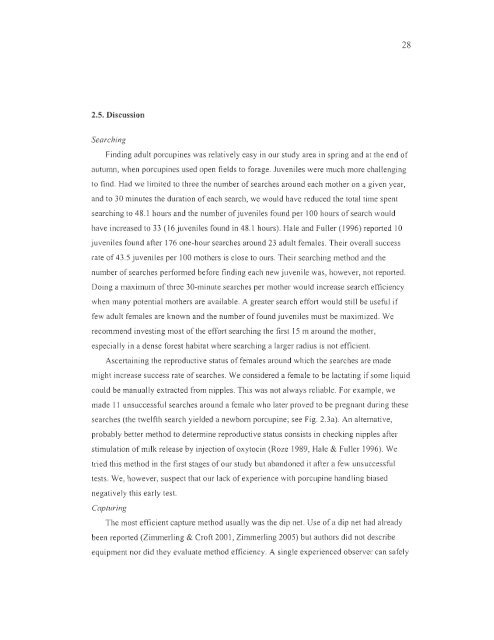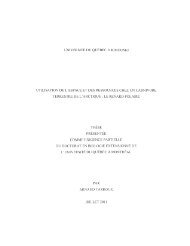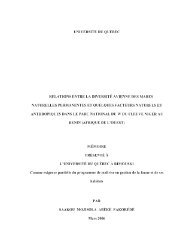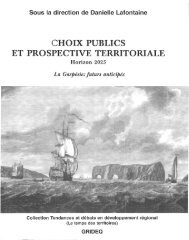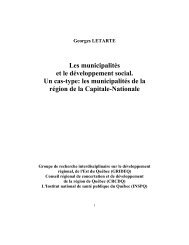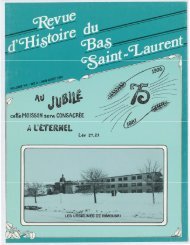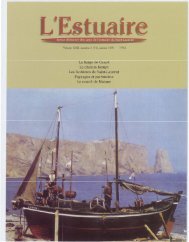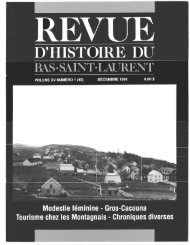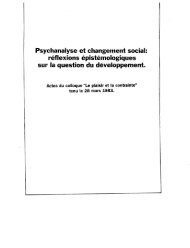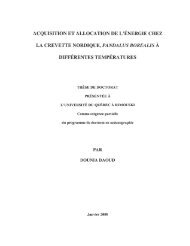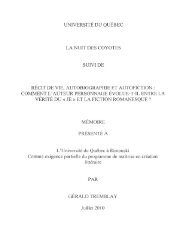influence du climat et de la prédation sur l'utilisation de l'habitat et la ...
influence du climat et de la prédation sur l'utilisation de l'habitat et la ...
influence du climat et de la prédation sur l'utilisation de l'habitat et la ...
You also want an ePaper? Increase the reach of your titles
YUMPU automatically turns print PDFs into web optimized ePapers that Google loves.
28<br />
2.5. Discussion<br />
Searching<br />
Finding a<strong>du</strong>lt porcupines was re<strong>la</strong>tively easy in our study area in spring and at the end of<br />
autumn, when porcupines used open fields to forage. Juveniles were much more challenging<br />
to find . Had we limited to three the number of searches around each mother on a given year,<br />
and to 30 minutes the <strong>du</strong>ration of each search, we would have re<strong>du</strong>ced the total time spent<br />
sem·ching to 48.1 hours and the number of juveniles found per 100 hours of search wou Id<br />
have increased to 33 (16 juveniJes found in 48.1 hours). Hale and Fuller (1996) reported 10<br />
juveniles found after 176 one-hour searches around 23 a<strong>du</strong>lt females. Their overall success<br />
rate of 43.5 juveniles per 100 mothers is close to ours. Their searching m<strong>et</strong>hod and the<br />
number of sem"ches performed before finding each new juvenile was, however, not reported.<br />
Doing a maximum of three 30-minute searches per mother would increase search efficiency<br />
when many potential mothers are avai<strong>la</strong>ble. A greater search effort wou Id still be useful if<br />
few a<strong>du</strong>lt females are known and the number offound juveniles must be maximized. We<br />
recommend investing most of the effort searching the first 15 m around the mother,<br />
especially in a <strong>de</strong>nse forest habitat where searching a <strong>la</strong>rger radius is not efficient.<br />
Ascel1aining the repro<strong>du</strong>ctive status of females around which the searches are ma<strong>de</strong><br />
might increase success rate ofsearches. We consi<strong>de</strong>red a female to be <strong>la</strong>ctating ifsome liquid<br />
COLI Id be manually extracted from nipples. This was not al ways reliable. For example, we<br />
ma<strong>de</strong> Il lInsuccessful searches around a female who <strong>la</strong>ter proved to be pregnant <strong>du</strong>ring these<br />
searches (the twelfth search yiel<strong>de</strong>d a newborn porcupine; see Fig. 2.3a). An alternative,<br />
probably b<strong>et</strong>ter m<strong>et</strong>hod to d<strong>et</strong>ermine repro<strong>du</strong>ctive status consists in checking nipples after<br />
stimu<strong>la</strong>tion of milk release by injection of oxytocin (Roze 1989, Hale & Fuller 1996). We<br />
tried this m<strong>et</strong>hod in the first stages of our study but abandoned it after a few unsuccessful<br />
tests. We, however, suspect that our <strong>la</strong>ck of experience with porcupine handling biased<br />
negatively this early test.<br />
Capu/ring<br />
The most efficient capture m<strong>et</strong>hod usually was the dip n<strong>et</strong>. Use of a dip n<strong>et</strong> had already<br />
been repol1ed (Zimmerling & Croft 2001 , Zimmerling 2005) but authors did not <strong>de</strong>scribe<br />
equipment nor did they evaluate m<strong>et</strong>hod efficiency. A single experienced observer can safely


